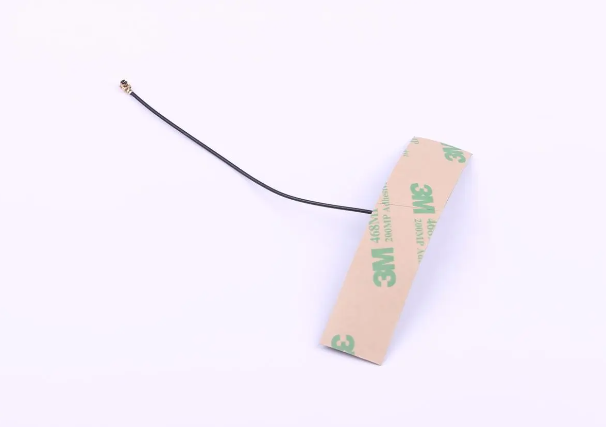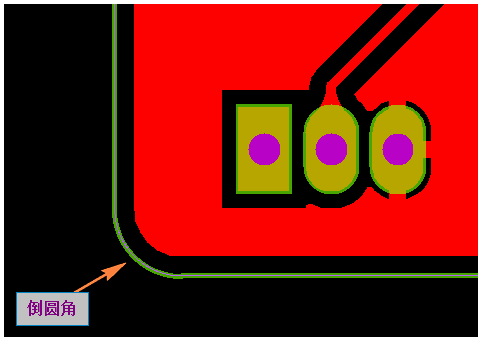当 PCB 外形是直角时, 通常工程制作外形 (锣带) 时, 会将直角或尖角的地方倒成圆角, 主要是为了防止板边容易划伤板且容易扎伤人
所以当客户没有特殊要求时, PCB 外形是直角一般会默认倒角 0.5mm 圆角(如下图所示)
一。 PCB 板边倒圆角点分析
原 PCB 外形 如下图图示: 看了这个 PCB 外形, 产生有 2 个问题点。
1. 外形中哪些点需倒圆角?
2. 如何怎么倒圆角?
1. 外形中哪些点需倒圆角?
看下图: PCB 外形倒圆角的点, 刚好就是我们凸包需求出的点, 接下来我们将玩转凸包了, 只要求出凸包, 那么就可以实现 PCB 板边倒圆角啦。
求凸包的算法: 我们可以借鉴算法导论中的查找凸包的算法(加以改进得到新的求凸包方法, 详见[方法一] 与[方法二] )
2. 如何怎么倒圆角?
在下面有说明倒角方法。
二。 求凸点
方法一求凸点:[采用多轮遍历, 一遍一遍将凹点踢除, 剩于的即是凸点]
方法一求凸点: 代码
/// 《summary》
/// 求最大多边形最大凸包 1 [采用多轮遍历将凹点踢除, 剩于的即是凸点]
/// 《/summary》
/// 《param name=“gSur_Point_list”》《/param》
/// 《returns》《/returns》
public List《gSur_Point》 s_convex_polyon1(List《gSur_Point》 gSur_Point_list)
{
bool isOK = true;
List《gSur_Point》 PointList = new List《gSur_Point》();
var isCCW = s_isCCW(gSur_Point_list);
int sum = gSur_Point_list.Count() - 1;
int n = gSur_Point_list.Count();
for (int i = 0; i 《n; i++)
{
int IndexPre = (i - 1) % sum;
if (IndexPre == -1) IndexPre = sum - 1;
int IndexCurrent = i % sum;
int IndexNext = (i + 1) % sum;
if (gSur_Point_list[IndexPre].type_point》 0) continue;
if (gSur_Point_list[IndexCurrent].type_point》 0) continue;
var multiVal = multi(gSur_Point_list[IndexPre].p, gSur_Point_list[IndexCurrent].p, gSur_Point_list[IndexNext].p);
if ((isCCW && multiVal》 0) || (!isCCW && multiVal 《0))
PointList.Add(gSur_Point_list[IndexCurrent]);
else
isOK = false;
}
List《gSur_Point》 Point2List = new List《gSur_Point》(PointList);
while (!isOK)
{
isOK = true;
PointList.Clear();
PointList.AddRange(Point2List);
Point2List.Clear();
sum = PointList.Count() - 1;
n = PointList.Count();
for (int i = 0; i 《n; i++)
{
int IndexPre = (i - 1) % sum;
if (IndexPre == -1) IndexPre = sum - 1;
int IndexCurrent = i % sum;
int IndexNext = (i + 1) % sum;
var multiVal = multi(PointList[IndexPre].p, PointList[IndexCurrent].p, PointList[IndexNext].p);
if ((isCCW && multiVal》 0) || (!isCCW && multiVal 《0))
Point2List.Add(PointList[IndexCurrent]);
else
isOK = false;
}
}
return Point2List;
}
方法二求凸包:[采用一边遍历找出凸点并加入队列, 并同时将队列中的凸点队列中找出凹点踢除]
方法二求凸包代码:
/// 《summary》
/// 求最大多边形最大凸包 2 [采用一边遍历找出凸点并加入队列, 并同时将队列中的凸点队列中找出凹点踢除]
/// 《/summary》
/// 《param name=“gSur_Point_list”》《/param》
/// 《returns》《/returns》
public List《gSur_Point》 s_convex_polyon2(List《gSur_Point》 gSur_Point_list)
{
Stack《gSur_Point》 StackPoint = new Stack《gSur_Point》();
var isCCW = s_isCCW(gSur_Point_list);
int sum = gSur_Point_list.Count() - 1;
int n = gSur_Point_list.Count();
for (int i = 0; i 《n; i++)
{
int IndexPre = (i - 1) % sum;
if (IndexPre == -1) IndexPre = sum - 1;
int IndexCurrent = i % sum;
int IndexNext = (i + 1) % sum;
if (gSur_Point_list[IndexPre].type_point》 0) continue;
if (gSur_Point_list[IndexCurrent].type_point》 0) continue;
var multiVal = multi(gSur_Point_list[IndexPre].p, gSur_Point_list[IndexCurrent].p, gSur_Point_list[IndexNext].p);
if ((isCCW && multiVal》 0) || (!isCCW && multiVal 《0))
{
L1:
if (StackPoint.Count》 1)
{
var Top1Point = StackPoint.Pop();
var Top2Point = StackPoint.Peek();
multiVal = multi(Top2Point.p, Top1Point.p, gSur_Point_list[IndexCurrent].p);
if ((isCCW && multiVal》 0) || (!isCCW && multiVal 《0))
StackPoint.Push(Top1Point);
else
goto L1;
}
StackPoint.Push(gSur_Point_list[IndexCurrent]);
}
}
return StackPoint.Reverse().ToList();
}
方法三求凸包:[按算法导论 Graham 扫描法 各节点按方位角 + 距离 逆时针排序 依次检查, 当不属凸点于则弹出]
方法三求凸包代码
/// 《summary》
/// 求最大多边形最大凸包 5 [按算法导论 Graham 扫描法 各节点按方位角 + 距离 逆时针排序 依次检查, 当不属凸点于则弹出]
/// 由于把各点的排列顺序重新排序了, 只支持折线节点(当存在弧节点时会出异常 !!!)
/// 《/summary》
/// 《param name=“gSur_Point_list”》《/param》
/// 《returns》《/returns》
public List《gSur_Point》 s_convex_polyon3(List《gSur_Point》 gSur_Point_list)
{
var LeftBottomPoint = gSur_Point_list.OrderBy(tt =》 tt.p.y).ThenBy(tt =》 tt.p.x).FirstOrDefault();
gSur_Point_list.RemoveAt(gSur_Point_list.Count - 1);
gSur_Point_list.ForEach(tt =》
{
tt.Value = p2p_di(LeftBottomPoint.p, tt.p);
tt.Angle = p_ang(LeftBottomPoint.p, tt.p);
}
);
gSur_Point_list = gSur_Point_list.OrderBy(tt =》 tt.Angle).ThenBy(tt =》 tt.Value).ToList();
gSur_Point_list.Add(gSur_Point_list[0]);
Stack《gSur_Point》 StackPoint = new Stack《gSur_Point》();
var isCCW = true;
int sum = gSur_Point_list.Count() - 1;
int n = gSur_Point_list.Count();
for (int i = 0; i 《n; i++)
{
int IndexPre = (i - 1) % sum;
if (IndexPre == -1) IndexPre = sum - 1;
int IndexCurrent = i % sum;
int IndexNext = (i + 1) % sum;
var multiVal = multi(gSur_Point_list[IndexPre].p, gSur_Point_list[IndexCurrent].p, gSur_Point_list[IndexNext].p);
if (isCCW && multiVal》 0)
{
L1:
if (StackPoint.Count》 1)
{
var Top1Point = StackPoint.Pop();
var Top2Point = StackPoint.Peek();
multiVal = multi(Top2Point.p, Top1Point.p, gSur_Point_list[IndexCurrent].p);
if (isCCW && multiVal》 0)
StackPoint.Push(Top1Point);
else
goto L1;
}
StackPoint.Push(gSur_Point_list[IndexCurrent]);
}
}
return StackPoint.Reverse().ToList();
}
公共方法与数据结构
/// 《summary》
/// Surface 坐标泛型集类 1
/// 《/summary》
public class gSur_Point
{
public gSur_Point()
{ }
public gSur_Point(double x_val, double y_val, byte type_point_)
{
this.p.x = x_val;
this.p.y = y_val;
this.type_point = type_point_;
}
public gSur_Point(gPoint p, byte type_point_)
{
this.p = p;
this.type_point = type_point_;
}
public gPoint p;
/// 《summary》
/// 0 为折点 1 为顺时针 2 为逆时针
/// 《/summary》
public byte type_point { get; set; } = 0;
/// 《summary》
/// 值
/// 《/summary》
public double Value { get; set; } = 0;
/// 《summary》
/// 角度
/// 《/summary》
public double Angle { get; set; } = 0;
/// 《summary》
/// 标记
/// 《/summary》
public bool isFalg { get; set; }
}
/// 《summary》
/// 点 数据类型 (XY)
/// 《/summary》
public struct gPoint
{
public gPoint(gPoint p_)
{
this.x = p_.x;
this.y = p_.y;
}
public gPoint(double x_val, double y_val)
{
this.x = x_val;
this.y = y_val;
}
public double x;
public double y;
public static gPoint operator +(gPoint p1, gPoint p2)
{
p1.x += p2.x;
p1.y += p2.y;
return p1;
}
public static gPoint operator -(gPoint p1, gPoint p2)
{
p1.x -= p2.x;
p1.y -= p2.y;
return p1;
}
public static gPoint operator +(gPoint p1, double val)
{
p1.x += val;
p1.y += val;
return p1;
}
public static bool operator ==(gPoint p1, gPoint p2)
{
return (p1.x == p2.x && p1.y == p2.y);
}
public static bool operator !=(gPoint p1, gPoint p2)
{
return !(p1.x == p2.x && p1.y == p2.y);
}
}
/// 《summary》
/// 求叉积 判断[点 P 与线 L] 位置关系[小于 0] 在右边 [大于 0] 在左边 [等于 0] 共线
/// 《/summary》
/// 《param name=“ps”》《/param》
/// 《param name=“pe”》《/param》
/// 《param name=“p”》《/param》
/// 《returns》[小于 0] 在右边 [大于 0] 在左边 [等于 0] 共线《/returns》
public double multi(gPoint ps, gPoint pe, gPoint p)
{
return ((ps.x - p.x) * (pe.y - p.y) - (pe.x - p.x) * (ps.y - p.y));
}
/// 《summary》
/// 检测 Surface 是否逆时针
/// 《/summary》
/// 《param name=“gSur_Point_list”》《/param》
/// 《returns》《/returns》
public bool s_isCCW(List《gSur_Point》 gSur_Point_list)
{
double d = 0;
int n = gSur_Point_list.Count() - 1;
for (int i = 0; i 《n; i++)
{
if (gSur_Point_list.type_point》 0) continue;
int NextI = i + 1 + (gSur_Point_list[i + 1].type_point》 0 ? 1 : 0);
d += -0.5 * (gSur_Point_list[NextI].p.y + gSur_Point_list.p.y) * (gSur_Point_list[NextI].p.x - gSur_Point_list.p.x);
}
return d》 0;
}
/// 《summary》
/// 返回两点之间欧氏距离
/// 《/summary》
/// 《param name=“p1”》《/param》
/// 《param name=“p2”》《/param》
/// 《returns》《/returns》
public double p2p_di(gPoint p1, gPoint p2)
{
return Math.Sqrt((p1.x - p2.x) * (p1.x - p2.x) + (p1.y - p2.y) * (p1.y - p2.y));
}
/// 《summary》
/// 求方位角
/// 《/summary》
/// 《param name=“ps”》《/param》
/// 《param name=“pe”》《/param》
/// 《returns》《/returns》
public double p_ang(gPoint ps, gPoint pe)
{
double a_ang = Math.Atan((pe.y - ps.y) / (pe.x - ps.x)) / Math.PI * 180;
// 象限角 转方位角 计算所属象限 并求得方位角
if (pe.x》= ps.x && pe.y》= ps.y) //↗ 第一象限
{
return a_ang;
}
else if (!(pe.x》= ps.x) && pe.y》= ps.y) // ↖ 第二象限
{
return a_ang + 180;
}
else if (!(pe.x》= ps.x) && !(pe.y》= ps.y)) //↙ 第三象限
{
return a_ang + 180;
}
else if (pe.x》= ps.x && !(pe.y》= ps.y)) // ↘ 第四象限
{
return a_ang + 360;
}
else
{
return a_ang;
}
}
View Code
三。 板边凸点倒圆角方法
方法一。 也最简单的倒角方法, 我们将 PCB 板边凸点找出来后, 可以直接借助 genesis 倒角功能就可以实现了
当然但偶尔会报错的, 且当 N 个小线段组成的尖角倒角会出错(要实现完美效果只有自己写倒角算法啦)
方法二: 自己写倒角算法, 这个算法和加内角孔算法类似 (这里只是介绍简单的倒角) 考虑特殊的需要扩展
四。 凸点加倒圆角实现效果
编辑:hfy
-
pcb
+关注
关注
4322文章
23124浏览量
398505
发布评论请先 登录
相关推荐
必看!PCB几层板设计的决定要素全解析
了解双面和多层pcb板的优缺点
中低频pcb板与高频pcb板区别

pcb没有工艺边怎么贴片
边OTG边充电芯片如何实现充电与数据传输并行?
边海防监控图像处理板怎么选?

PCB天线设计原理解析





 基于PCB 板的边倒圆角实现方案解析
基于PCB 板的边倒圆角实现方案解析











评论